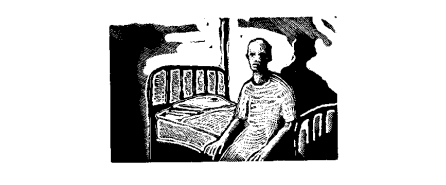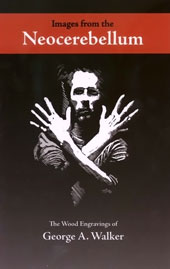The Porcupine's Quill
Celebrating forty years on the Main Street
of Erin Village, Wellington County
BOOKS IN PRINT
Images from the Neocerebellum by George A. Walker
The Mad Hatter of the contemporary Canadian graphic arts, wood engraver George A. Walker considers the passage of time as it unfolds from the pages of his personal dream diary.

The Mad Hatter of contemporary Canadian graphic arts, wood engraver George A. Walker considers the passage of time as it unfolds from the binding of his personal dream diary.
Walker was introduced to the concept of a visual dream diary in John MacGregor’s ‘Inscape Psychology’ courses at the Ontario College of Art in the 1980s. An essential part of the course requirement insisted each student keep a daily dream diary. The methodology was simple enough: set an alarm clock with an urgent mechanism in the evening primed to startle the dreaming student to sudden wakefulness in the morning, then set to paper immediately whatever fragments could be salvaged from a fitful night before the fanciful thoughts dissipated in the bright glare of dawn. Walker became obsessed with the practice and continues to record his dreams daily, twenty-five years further on. Often in the nineteenth-century medium of wood engraving, pushing sharpened burins into the planed surface of endgrain Canadian maple.

2008—Independent Publisher (IPPY) awards,
Runner-up
For over twenty years George A. Walker has compulsively maintained a visual dream diary of images remembered from his resonant sleep. Inspired by Carl Jung’s theories of dreaming and the dream’s relation to the unconscious Walker began to explore the dioramas encountered in his enchantment, distilling them into single black and white images in an effort to capture unconscious moments in time. Many of these same images have subsequently been transferred onto endgrain wood blocks and hand printed in limited letterpress editions. As Walker claims, ‘dreams are the bones of the psyche, which is where all our understanding of self begins and ends.’
Why is it that the black and white image is so compelling? The human eye consists of rods and cones that process the reflected light of our world. These signals are then translated into colour and form for processing by the brain. The rods, however, are considered one of the most primitive organs in the eye and are sensitive only to black and white. These rods are the first component of the eye to be activated at birth and this explains why infants respond readily to high contrast black and white images. It could be said, then, that human beings are ‘hard-wired’ to read black and white artwork. It is this instinctive physical attraction that drives Walker’s exploration of the high contrasts intrinsic to wood engraving prints.
The neocerebellum is the part of the cerebellum that controls visual-spacial, procedural learning and the preparation of complex movements such as would be required in the engraving of lines on a wood block. Many psychologists believe the cerebellum is where our dreams originate. Since the cerebellum is in control of the emotions and self-awareness it is one key to understanding how the brain organizes its unconscious self.
In the United States, Walker is known for his many collaborations with the bestselling novelist Neil Gaiman, author of Anansi Boys, American Gods and Neverwhere and the creator/writer of the monthly cult DC Comics horror-weird series, Sandman. Walker has published two Biting Dog Press editions of Gaiman’s writing -- Murder Mysteries and Snow Glass Apples.
In Canada, Walker is perhaps best-known for the ninety-six wood engravings he created to illustrate the Cheshire Cat Press edition of Lewis Carroll’s Alice’s Adventures in Wonderland (1988) which was printed by hand in 177 copies by Walker’s long-time mentor Bill Poole at the Poole Hall Press. Wonderland was followed, in 1998, by yet another Cheshire Cat edition of Through the Looking Glass and What Alice Found There which may have given rise to Walker’s current reputation as the Mad Hatter of the Canadian graphic arts, an artist of ‘sustained and wacky integrity half way between Jose Posada and Krazy Kat’.
Review quote
‘George Walker is one of the most unusual wood engravers in the country, and works in a distinctly contemporary idiom. Using a dentist’s drill, he routs out deep grooves which create bold graphic white lines, providing a brilliant black-white contrast.’
—Patricia Ainslie, Glenbow Museum
Review quote
‘Walker’s engravings are distanced from the twentieth-century English tradition exemplified by Gill and Gillings: for example, he often uses a dentist’s drill to rout out deep grooves. This is not an inconsequential labour-saving technique: it gives the images more of a folk-art feel and dramatizes his symbolic and often surreal compositions.’
—Paul Razzell, Parenthesis
Review quote
‘Warning: Reading this book will affect your sleep.’
—Michael Lieberman, Book Patrol
Review quote
‘Paired with brief explicatory entries describing the pictures, the pages of the book chart a passage into an irrational world in which a central character finds himself in a Kafkaesque world, wandering alienated in a strange space. Others show odd juxtapositions of recognizable things -- a tree coming out of a mouth, a person in a bed with oversized hands, pierced faces, and a puzzling device of a circus performer flanked by two barking wolves balancing on balls, arranged as if a heraldic device.’
—Tom Smart, Devil’s Artisan
Author comments
‘I believe dreams are the bones of the psyche, which is where all our understanding of self begins and ends. The dream diary is the most abstract and visually absurd sequential inner narrative. Although the events and images may seem not to have a relationship to one another, it is the very circumstance that the Dreamer is the Story that brings it all together as a single work.’
—George A. Walker
George A. Walker is an award-winning wood engraver, book artist and author whose courses in book arts and printmaking at OCAD University in Toronto, where he is Associate Professor, have been offered continuously since 1985. His artworks are held in collections ranging from the Fisher Rare Book Library, University of Toronto, The Morgan Library & Museum, New York, and The Museum of Modern Art (MoMa), New York City and he has had over 15 solo exhibitions as well as been included in more than 100 group shows. Among many book projects—both trade and limited edition—Walker has illustrated 2 hand-printed books by internationally acclaimed author Neil Gaiman. Walker also illustrated the first Canadian edition of Lewis Carroll’s Alice’s Adventures in Wonderland and Alice Through the Looking Glass, both published by the Cheshire Cat Press. The Cheshire Cat Press is a partnership between Andy Malcolm and George Walker which continues to publish limited edition books featuring the writing of Lewis Carroll.
George Walker was elected to the Royal Canadian Academy of Art in 2002 for his contribution to the cultural area of Book Arts. He is also a member of the Arts and Letters Club of Toronto where he was featured in a solo exhibition of his books and printmaking in the spring of 2019. Walker’s latest book-length project presents the iconic life of Hollywood silent-film star Mary Pickford in a suite of 87 wood engravings.
For more information please visit the Author’s website »
The Porcupine's Quill would like to acknowledge the support of the Ontario Arts Council and the Canada Council for the Arts for our publishing program. The financial support of the Government of Canada through the Canada Book Fund (CBF) is also gratefully acknowledged.





